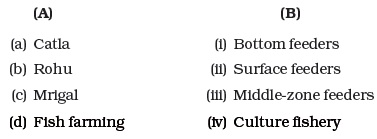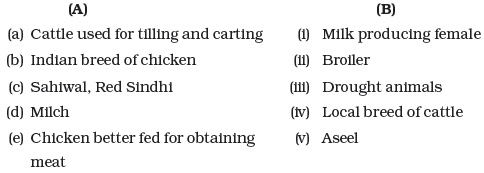Candidates can download NCERT Exemplar Class 9 Science Unit 15 from this page. The exemplar has been provided by the National Council of Educational Research & Training (NCERT) and the candidates can check it from below for free of cost. It contains objective, very short answer type, short answer type, and long answer type questions. Along with it, the answer for each question has also been provided. From the NCERT Exemplar Class 9 Science Unit 15, candidates can understand the level and type of questions that are asked in the exam.
NCERT Exemplar Class 9 Science Unit 15 Improvement In Food Resources
NCERT Class 9 Science Unit 15 is for Improvement In Food Resources. The type of questions that will be asked from NCERT Class 9 Science Unit 15 are displayed in the below provided NCERT Exemplar Class 9 Science Unit 15. With the help of it, candidates can prepare well for the examination.
Also Check NCERT Solutions for Class 9 Science
Multiple Choice Questions
- Which one is an oil yielding plant among the following?
(a) Lentil
(b) Sunflower
(c) Cauliflower
(d) Hibiscus - Which one is not a source of carbohydrate?
(a) Rice
(b) Millets
(c) Sorghum
(d) Gram - Find out the wrong statement from the following
(a) White revolution is meant for increase in milk production
(b) Blue revolution is meant for increase in fish production
(c) Increasing food production without compromising with environmental quality is called as sustainable agriculture
(d) None of the above - To solve the food problem of the country, which among the following is necessary?
(a) Increased production and storage of food grains
(b) Easy access of people to the food grain
(c) People should have money to purchase the grains
(d) All of the above - Find out the correct sentence
(i) Hybridisation means crossing between genetically dissimilar plants
(ii) Cross between two varieties is called as inter specific hybridisation
(iii) Introducing genes of desired character into a plant gives genetically modified crop
(iv) Cross between plants of two species is called as inter varietal hybridisation
(a) (i) and (iii)
(b) (ii) and (iv)
(c) (ii) and (iii)
(d) (iii) and (iv) - Weeds affect the crop plants by
(a) killing of plants in field before they grow
(b) dominating the plants to grow
(c) competing for various resources of crops (plants) causing low availability of nutrients
(d) all of the above. - Which one of the following species of honey bee is an Italian species?
(a) Apis dorsata
(b) Apis florae
(c) Apis cerana indica
(d) Apis mellifera - Find out the correct sentence about manure
(i) Manure contains large quantities of organic matter and small quantities of nutrients.
(ii) It increases the water holding capacity of sandy soil.
(iii) It helps in draining out of excess of water from clayey soil.
(iv) Its excessive use pollutes environment because it is made of animal excretory waste.
(a) (i) and (iii)
(b) (i) and (ii)
(c) (ii) and (iii)
(d) (iii) and (iv) - Cattle husbandry is done for the following purposes
(i) Milk Production
(ii) Agricultural work
(iii) Meat production
(iv) Egg production
(a) (i), (ii) and (iii)
(b) (ii), (iii) and (iv)
(c) (iii) and (iv)
(d) (i) and (iv) - Which of the following are Indian cattle?
(i) Bos indicus
(ii) Bos domestica
(iii) Bos bubalis
(iv) Bos vulgaris
(a) (i) and (iii)
(b) (i) and (ii)
(c) (ii) and (iii)
(d) (iii) and (iv) - Which of the following are exotic breeds?
(i) Brawn
(ii) Jersey
(iii) Brown Swiss
(iv) Jersey Swiss
(a) (i) and (iii)
(b) (ii) and (iii)
(c) (i) and (iv)
(d) (ii) and (iv) - Poultry farming is undertaken to raise following
(i) Egg production
(ii) Feather production
(iii) Chicken meat
(iv) Milk production
(a) (i) and (iii)
(b) (i) and (ii)
(c) (ii) and (iii)
(d) (iii) and (iv) - Poultry fowl are susceptible to the following pathogens
(a) Viruses
(b) Bacteria
(c) Fungi
(d) All of the above - Which one of the following fishes is a surface feeder?
(a) Rohus
(b) Mrigals
(c) Common carps
(d) Catlas - Animal husbandry is the scientific management of
(i) animal breeding
(ii) culture of animals
(iii) animal livestock
(iv) rearing of animals
(a) (i), (ii) and (iii)
(b) (ii), (iii) and (iv)
(c) (i), (ii) and (iv)
(d) (i), (iii) and (iv) - Which one of the following nutrients is not available in fertilizers?
(a) Nitrogen
(b) Phosphorus
(c) Iron
(d) Potassium - Preventive and control measures adopted for the storage of grains include
(a) strict cleaning
(b) proper disjoining
(c) fumigation
(d) all of the above
Short Answer Type Questions
- Match the column A with the column B

- Fill in the blanks
(a) Pigeon pea is a good source of ______ .
(b) Berseem is an important ______ crop.
(c) The crops which are grown in rainy season are called ______ crops.
(d) ______ are rich in vitamins.
(f) ______ crop grows in winter season. - What is a GM crop? Name any one such crop which is grown in India.
- List out some useful traits in improved crop?
- Why is organic matter important for crop production?
- Why is excess use of fertilizers detrimental for environment?
- Give one word for the following
(a) Farming without the use of chemicals as fertilizers, herbicides and pesticides is known as ______ .
(b) Growing of wheat and groundnut on the same field is called as ______ .
(c) Planting soyabean and maize in alternate rows in the same field is called as ______ .
(d) Growing different crops on a piece of land in pre-planned succession is known as ______ .
(e) Xanthium and Parthenium are commonly known as ______ .
(f) Causal organism of any disease is called as ______ . - Match the following A and B

- If there is low rainfall in a village throughout the year, what measures will you suggest to the farmers for better cropping?
- Group the following and tabulate them as energy yielding, protein yielding, oil yielding and fodder crop.
Wheat, rice, berseem, maize, gram, oat, pigeon gram, sudan grass, lentil, soyabean, groundnut, castor and mustard. - Define the term hybridization and photoperiod.
- Fill in the blanks
(a) Photoperiod affect the ______ .
(b) Kharif crops are cultivated from ______ to ______ .
(c) Rabi crops are cultivated from ______ to ______ .
(d) Paddy, maize, green gram and black gram are ______ crops.
(e) Wheat, gram, pea, mustard are ______ crops. - Cultivation practices and crop yield are related to environmental condition. Explain.
- Fill in the blanks
(a) A total of ______ nutrients are essential to plants.
(b) ______ and ______ are supplied by air to plants.
(c) ———is supplied by water to plants.
(d) Soil supply ______ nutrients to plants.
(e) ______ nutrients are required in large quantity and called as ______ .
(f) ______ nutrients are needed in small quantity for plants and are called ______ . - Differentiate between compost and vermicompost?
- Arrange these statements in correct sequence of preparation of green manure.
(a) Green plants are decomposed in soil.
(b) Green plants are cultivated for preparing manure or crop plant parts are used.
(c) Plants are ploughed and mixed into the soil.
(d) After decomposition it becomes green manure. - An Italian bee variety A. mellifera has been introduced in India for honey production. Write about its merits over other varieties.
- In agricultural practices, higher input gives higher yield. Discuss how?
Long Answer Type Questions
- Discuss the role of hybridisation in crop improvement.
- Define (i) Vermicompost
(ii) Green manure
(iii) Bio fertilizer - Discuss various methods for weed control.
- Differentiate between the following
(i) Capture fishery and Culture fishery
(ii) Mixed cropping and Inter cropping
(iii) Bee keeping and Poultry farming - Give the merits and demerits of fish culture?
- What do you understand by composite fish culture?
- Why bee keeping should be done in good pasturage?
- Write the modes by which insects affect the crop yield.
- Discuss why pesticides are used in very accurate concentration and in very appropriate manner?
- Name two types of animal feed and write their functions.
- What would happen if poultry birds are larger in size and have no summer adaptation capacity? In order to get small sized poultry birds, having summer adaptability, what method will be employed?
- Suggest some preventive measures for the diseases of poultry birds.
- Figure 15.1 shows the two crop fields [Plots A and B] have been treated by manures and chemical fertilizers respectively, keeping other environmental factors same. Observe the graph and answer the following questions.
(i) Why does plot B show sudden increase and then gradual decrease in yield?
(ii) Why is the highest peak in plot A graph slightly delayed?
(ii) What is the reason for the different pattern of the two graphs?

- Complete the crossword puzzle (Fig.15.2)

Across-
- 1. Oil yielding plant (9)
- 3. Crop grown in winter season (4)
- 5. Fixed by Rhizobium (8)
- 9. Common honey bee (4)
Downward
- 2. Animal feed (6)
- 4. A micronutrient (5)
- 6. Unwanted plant in crop fields (4)
- 7. An exotic breed of chicken(7)
- 8. Bottom feeders in fish pond(7)
- 10. A marine fish (4)
-
| « Previous |
Answers
To get study material, exam alerts and news, join our Whatsapp Channel.









